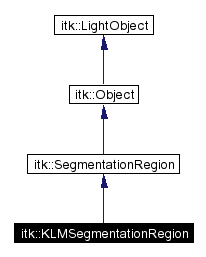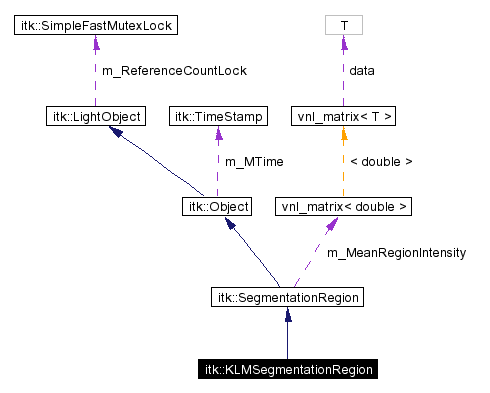
#include <itkKLMSegmentationRegion.h>
Inheritance diagram for itk::KLMSegmentationRegion:


itkKLMSegmentationRegion is the base class for the KLMSegmentationRegion objects. It provides the basic function definitons that are inherent to a KLMSegmentationRegion objects. It is templated over the type of input and output image.
This object supports data handling of multiband images. The object accepts images in vector format, where each pixel is a vector and each element of the vector corresponds to an entry from 1 particular band of a multiband dataset.
We expect the user to provide the input to the routine in vector format. A single band image is treated as a vector image with a single element for every vector.
Data structures for a regions ============================= A region is defined as a closed area in the image that is surrounded by a list of borders objects (see itkKLMSegmentationBorder class).
Shown below is an initial 4x3 grid size partition of a 8x9 image. The initial region blocks are labeled in hexadecimal, and the region borders are shown as E = border pixel, and C = non-border pixel. Note that the border pixel grid is one pixel larger than the region grid. The border pixel grid can be considered to lie interspersed within the region pixel grid with four border pixels surrounding each interior region pixel.
\begin{center} Initial regions of a 8 by 9 image with a 4 by 3 grid partition. \ \begin{tabular}{|c|c|c|c|c|c|c|c|c|} \hline 1 & 1 & 1 & 2 & 2 & 2 & 3 & 3 & 3 \ \hline 1 & 1 & 1 & 2 & 2 & 2 & 3 & 3 & 3 \ \hline 4 & 4 & 4 & 5 & 5 & 5 & 6 & 6 & 6 \ \hline 4 & 4 & 4 & 5 & 5 & 5 & 6 & 6 & 6 \ \hline 7 & 7 & 7 & 8 & 8 & 8 & 9 & 9 & 9 \ \hline 7 & 7 & 7 & 8 & 8 & 8 & 9 & 9 & 9 \ \hline a & a & a & b & b & b & c & c & c \ \hline a & a & a & b & b & b & c & c & c \ \hline \end{tabular} \end{center}
\begin{center} Region borders are shown as ``E''. \ \begin{tabular}{|c|c|c|c|c|c|c|c|c|c|} \hline C & C & C & E & C & C & E & C & C & C \ \hline C & C & C & E & C & C & E & C & C & C \ \hline E & E & E & E & E & E & E & E & E & E \ \hline C & C & C & E & C & C & E & C & C & C \ \hline E & E & E & E & E & E & E & E & E & E \ \hline C & C & C & E & C & C & E & C & C & C \ \hline E & E & E & E & E & E & E & E & E & E \ \hline C & C & C & E & C & C & E & C & C & C \ \hline C & C & C & E & C & C & E & C & C & C \ \hline \end{tabular} \end{center}
Definition at line 96 of file itkKLMSegmentationRegion.h.
|
|
Reimplemented from itk::SegmentationRegion. Definition at line 107 of file itkKLMSegmentationRegion.h. |
|
|
Reimplemented from itk::SegmentationRegion. Definition at line 106 of file itkKLMSegmentationRegion.h. |
|
|
Type definition for the region border vector iterators to be used. Definition at line 121 of file itkKLMSegmentationRegion.h. |
|
|
Type definition for vector container that stores the borders associated with a current region. Definition at line 118 of file itkKLMSegmentationRegion.h. |
|
|
Standard class typedefs. Reimplemented from itk::SegmentationRegion. Definition at line 104 of file itkKLMSegmentationRegion.h. |
|
|
Reimplemented from itk::SegmentationRegion. Definition at line 105 of file itkKLMSegmentationRegion.h. |
|
|
|
|
|
|
|
|
Delete all region borders |
|
|
Delete a region border. |
|
|
Run-time type information (and related methods). Reimplemented from itk::SegmentationRegion. |
|
|
Get the first border associated with a region. |
|
|
Get a head pointer to the vector containter storing the borders associated with a region. |
|
|
Get a tail pointer to the vector containter storing the borders associated with a region. |
|
||||||||||||
|
Insert a region border. |
|
|
Method for creation through the object factory. Reimplemented from itk::SegmentationRegion. |
|
|
Function that allows printing of the region parameters using std::cout. |
|
||||||||||||
|
Methods invoked by Print() to print information about the object including superclasses. Typically not called by the user (use Print() instead) but used in the hierarchical print process to combine the output of several classes. Reimplemented from itk::SegmentationRegion. |
|
|
Reorder the region borders given a candidate border after region merging. |
|
||||||||||||||||
|
Set the region with parameter values defining the region. |
|
|
Set the border associated with a region. |
|
|
Set the border associated with a region. |
|
|
Recalculate the lambda values for all the borders defining the region and resort the entire border list in decending order of the lambda values. |
 1.2.15 written by Dimitri van Heesch,
© 1997-2000
1.2.15 written by Dimitri van Heesch,
© 1997-2000